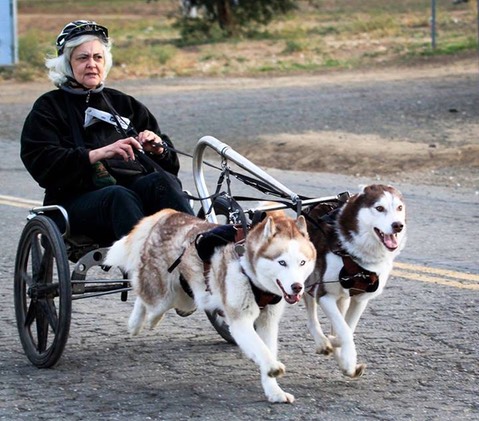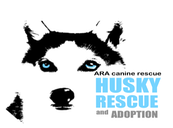
As any husky lover knows, there is nothing these dogs adore more than to run, and to pull. It's what they were bred for, for thousands of years, and the urge is strong. So strong that, if they don't get enough outlet for that urge, they can be unhappy, and their unhappiness can manifest in ways which can be difficult to live with in the modern world.
After having run and hiked extensively for decades, not long after I got Tashi, I developed a degenerative back disorder. What to do? As it got worse, how could I give him the exercise I knew he needed? The sport of "urban mushing" was becoming popular, but bikes and scooters would become as impossible for me as hiking, or even walking.
So I did a lot of research, and I discovered the canine dorsal-shaft sulky, a relatively new concept which replaces the more rigid, "dual-shaft" design with a single dorsal shaft which provides lift and is freer for the dog. Unlike horses, dogs' backs can't handle weight; the dorsal shaft allows the rider's weight to actually lift a bit, reducing the effort needed by the dog.
The rule of thumb is that a healthy dog can pull 2½ to 3 times its body weight by 18 months (so their growth plates have time to set). Training can begin at any age. At six feet tall, with a sulky weighing 43 lbs., I needed a second dog, so we got Kochyok. Training was easy for me; being huskies, both dogs took to it like "a duck to water". We use the same commands as mushers, and the training is virtually identical. There is a wonderful Facebook group with knowledgeable people who are always willing to help.
I was lucky enough to find Regal Canine Sulkies before they went out of production. Engineered by a man who built horse sulkies for over 40 years, it opened up new vistas for people like me. There are a lot of rigs out there, most of which are unhealthy, in some cases even unsafe, for dogs and/or humans. However, ChaloSulky produces a good rig based on the same principles as Regals. They make an excellent product and are the only sulkies I can honestly recommend. They also have a lot of useful information about training.
Another option is the slightly heavier, dual-shaft, 4-wheeled Norwegian Sacco Dog Cart (now made in America). Sacco has been around since WWII and is a highly-respected manufacturer. Their rigs are very popular in Europe, built to last, can accommodate up to four dogs, have a weight limit of 400 lbs., and can go virtually anywhere. With four-wheeled disc brakes, a chromoly-steel chasis, spring-loaded tow bars and their "Kanti-Link" suspension, Saccos are truly the closest thing to snow mushing on land.
The initial cost of a sulky is high, $1,300-$1,500 (Sacco carts, $3,000), tho' used Chalos and even used Regals show up regularly. For good reason; they last forever, and maintenance is virtually nil. They require a specialized harness, which can run $175-$275, and a bit of other tack: reins, driving collar, neckline, extra tug lines for more dogs. You can run up to four dogs on a sulky easily utilizing extra tug lines. All this is available at Chalo, as well as excellent training materials. Didgee Harness also makes excellent tack.
So we joined the sport we call "dog driving", a subset of urban mushing. Beginning with local paved multi-use pathways, we graduated to fire roads and even single-track trails. We now run on our own on weekdays; weekends we run with an urban mushing group who all ride bikes and scooters. We have yet to encounter a trail they can do that we cannot. In some cases, because of my parallel wheels, we can comfortably traverse trails THEY cannot. We see wildlife every day, we chase rabbits and deer, much to the joy of the dogs, and I've never had a serious accident. How many urban mushers can say that?
I am all in favor of getting these wonderful dogs out, burning off that energy they were bred to possess. I have also learned much about the value of sulkies. I know fosters and rescues have found it wonderful for dogs from bad beginnings: dogs with a lack of confidence, dogs who need structure, dogs who need to learn to work as a team, and dogs who never got the chance to be DOGS, to feel the freedom of running at their own speed.
It's a real blessing for those of us who are elderly and/or who have physical disabilities. It's now the only way I would get out in nature, and I know people who depend on their service dogs and a sulky to do their shopping and get around town.
At 68 years of age, I can no longer walk far, and that only with the aid of a cane. But my dogs and I still get out six days a week, going on five years now, in all weather. We run 4-5 miles in the morning, and they happily crash for the rest of the day. I still get up as early as 4 a.m. in Summer; I always curse when the alarm gets off, but as soon as we're on the trail, I'm glad I did. I can honestly say it is the joy of my life, and theirs.
Niki Beecher
